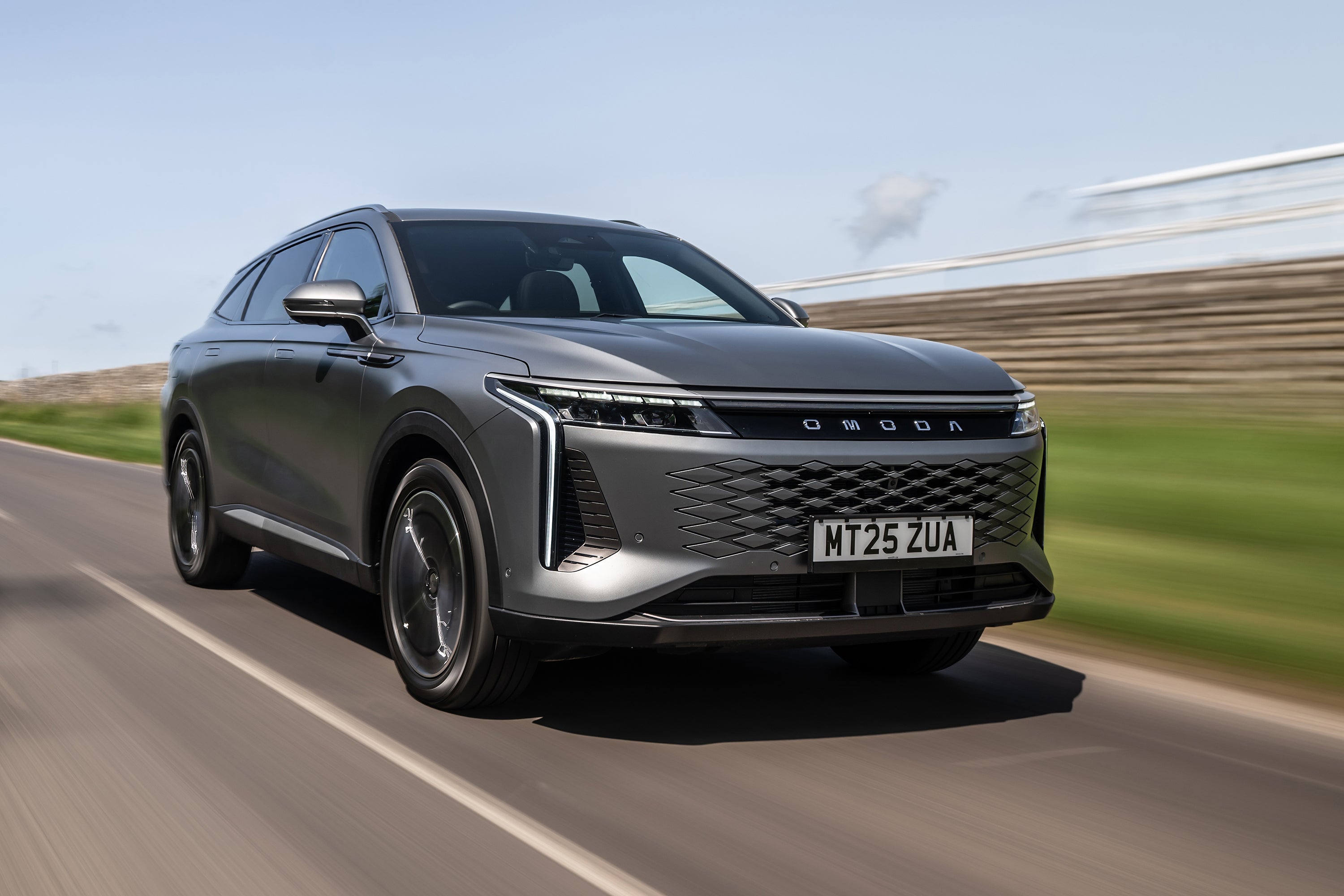Omoda 9 Review 2025: Price, specs & boot space
Written by Ivan Aistrop
- 2025
- SUV
- PHEV
Quick overview
Pros
- Genuinely lovely interior
- Lots of passenger and boot space
- Heaving list of standard equipment
Cons
- Some ergonomic wrinkles need ironing out
- Average - but certainly not bad - to drive
- From a little-known brand in the UK
Verdict: Is the Omoda 9 a good car?
"Omoda is probably a name that’s not massively familiar to you, and that’s because this Chinese car brand has only recently landed in Europe. And this, the Omoda 9 SUV, is the brand’s flagship, so represents the best it has to offer. But is it any good? Find out in our Omoda 9 review."
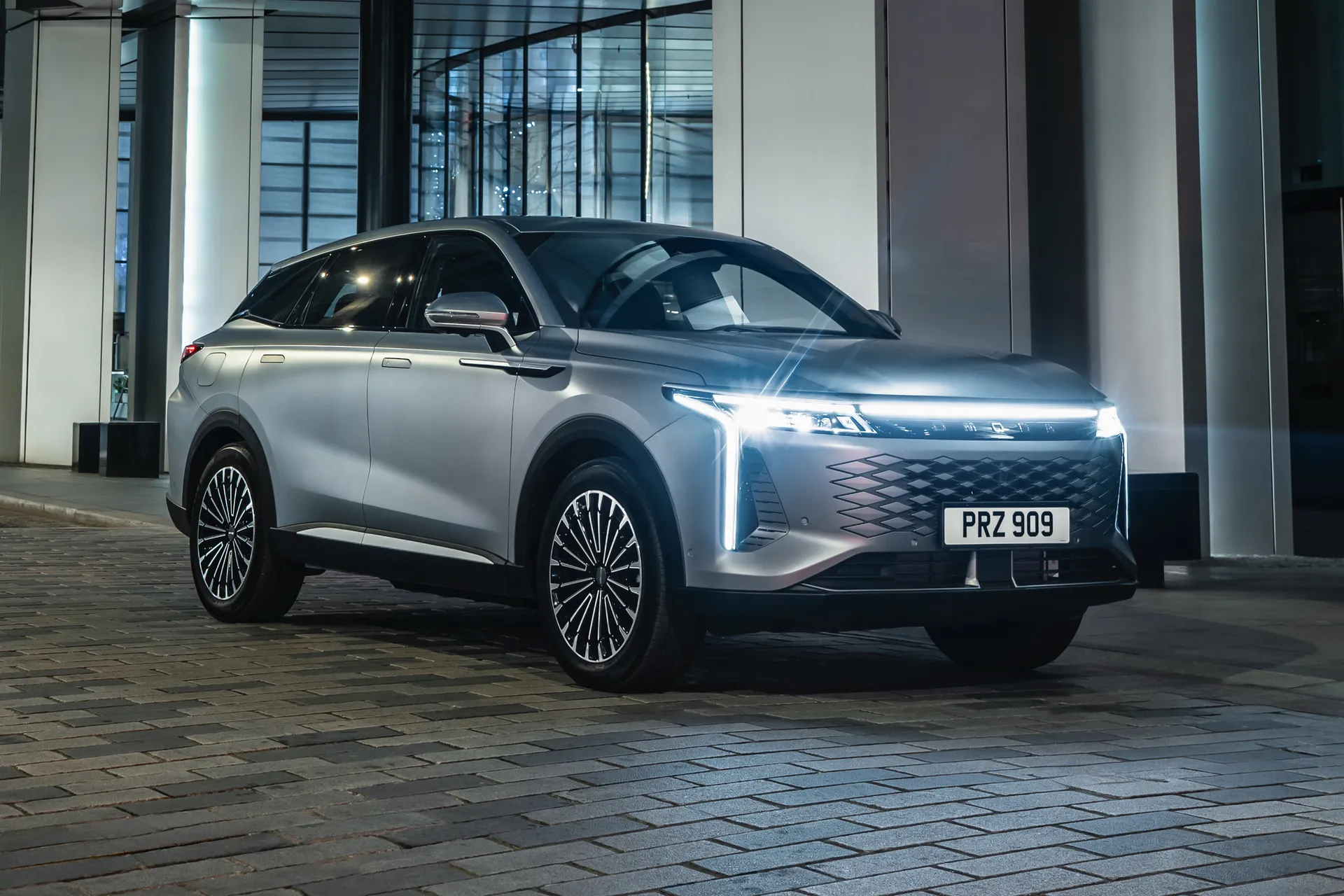
Let’s begin by giving you a wee bit of context on the Omoda brand and where it’s come from. It’s part of a massive Chinese manufacturing company called Chery, which has been going for donkey’s years and is China's leading exporter of new cars around the world. Big business, then.
Chery uses a variety of different brand names depending on whereabouts in the world it happens to be marketing its cars. Omoda, and sister brand Jaecoo, are the names that have been chosen to spearhead Chery’s entry into the European market. Omoda launched in the UK at the end of 2024, and Jaecoo followed soon after in early 2025. Both brands kicked off their UK offerings with smaller SUVs, the Omoda 5 and the Jaecoo 7.
The Omoda 9 sits proudly at the top of Omoda’s range as the brand’s flagship. It’s a large five-seater SUV that’s offered exclusively with a powerful plug-in hybrid powertrain, and in one single high-spec trim level: Omoda’s ethos on this is ‘everything as standard’. Indeed, the car is so well equipped as standard that the only optional extra available is the exterior paint. And crucially, all of this is provided for a price that undercuts premium rivals by thousands.
But if Omoda is pitching the 9 against premium rivals, does it genuinely deliver a premium experience? Well, for the most part, yes it does. It has limousine-like levels of cabin space and a big boot, while the interior is genuinely lovely, with plush materials and a tasteful design. All that standard kit adds further to that luxury feel, as do the large digital screens that dominate the dashboard, although as we’ll come to later, these aren’t perfect from an ergonomic point of view.
And while the Omoda 9 isn’t the most dynamically polished luxury car you’ll ever drive, it’s good enough in both the ride and handling stakes to be convincing and capable. It’s a relaxing and easy-going car to drive, and refinement is excellent, while the powertrain is smooth and can take you up to 93 miles on a full charge of the battery.
All in all, the Omoda 9 certainly isn’t perfect, but it’s nowhere near as flawed as other Omoda/Jaecoo models we’ve tried, and for those looking for a luxury SUV experience for more like a mainstream SUV price, the car will be pretty compelling.
Is the Omoda 9 right for you?
If you want a large, premium-feeling, plug-in-hybrid SUV on your driveway, but you don’t want to pay premium prices for it, then the Omoda 9 could be a good option. You’ll also get lots of space, bags of standard equipment, a plush-feeling interior and a long warranty for your money. You’ll be taking a punt on a little-known brand, and you might get bored of explaining what it is to people, but if you don’t mind that, then the Omoda 9 looks like great value.
What's the best Omoda 9 model/engine to choose?
Well, that’s nice and easy, because there’s only one powertrain available - a plug-in hybrid one - and one high-spec, everything-as-standard trim level. And, there are no optional extras to speak of. So, apart from the paint colour, all examples of the Omoda 9s are exactly the same.
What other cars are similar to the Omoda 9
That kinda depends on what you’re talking about. There are plenty of large luxurious SUVs out there, and ones with hybrid powertrains. We’re thinking cars like the Range Rover Velar, Volvo XC60, Mercedes GLC. However, the Omoda 9 undercuts these rivals by many thousands on price, and in most cases, comes with significantly more standard equipment.
The 9 is more comparable on price with more mainstream PHEV SUVs such as the Volkswagen Tiguan and Toyota RAV4. However, these rivals are also significantly smaller (although still not small), and again, aren’t as well equipped as standard.
Comfort and design: Omoda 9 interior
"The Omoda 9 has luxury SUV pretensions, and the good news is that it feels like it from the driver’s seat."
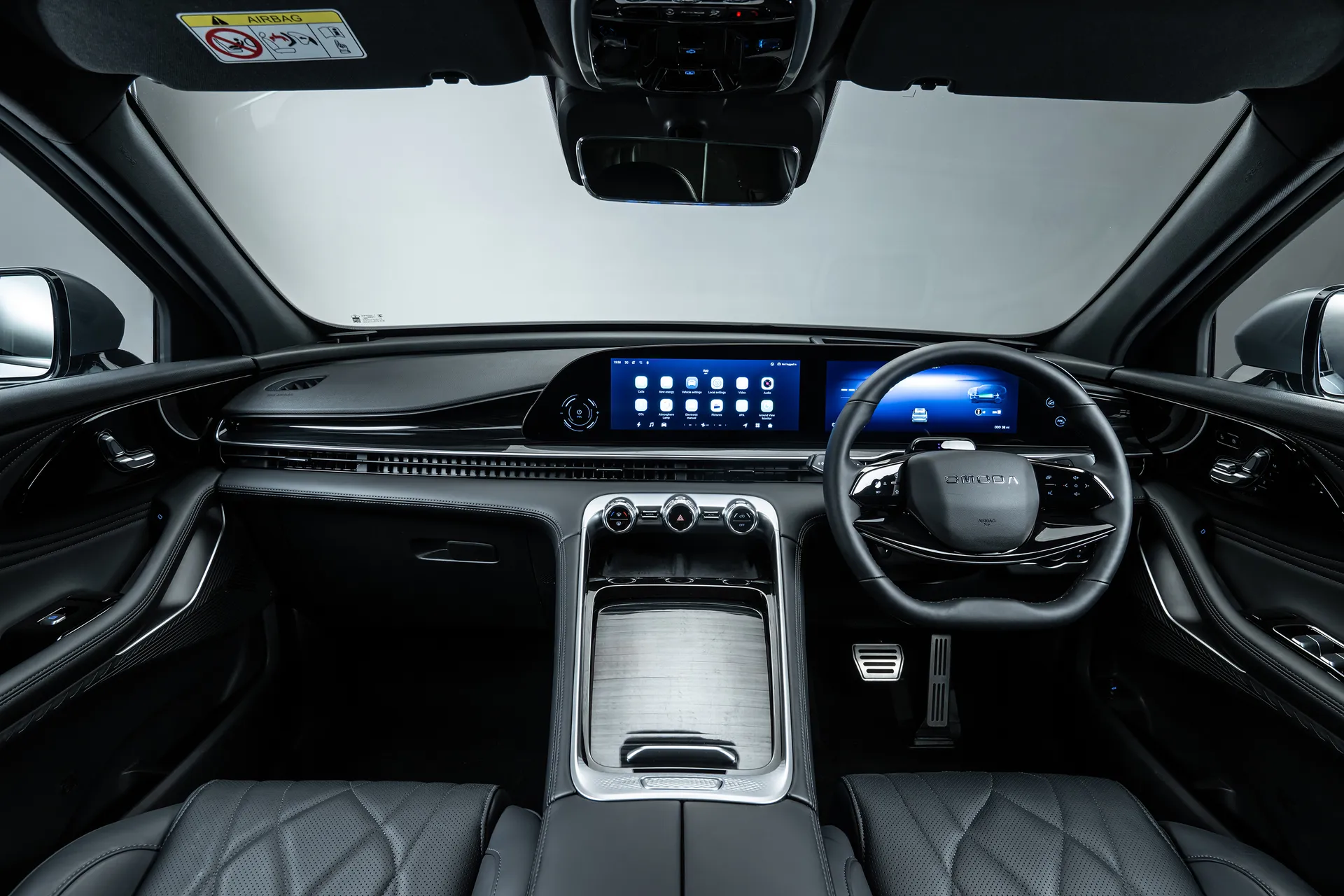
Much of that is down to the quality and technology you’re faced with, which we’ll talk about more in a moment when the appropriate sections come along, but you’ll like that there’s extensive electric adjustment for your driving position, and that goes for both your seat and steering column. Whatever you do with the adjusters, you sit quite high, and some drivers might wish their chair went lower, but most SUV drivers favour a high seating position so it shouldn’t be a problem for them. The seats give decent support, too, but wherever you set your seat, the car’s tiny rear window means your over-the-shoulder visibility isn’t great.
If we’re honest, the interior design feels like something of a change of tack from Omoda/Jaecoo. While in other models, physical switchgear has been kept to a minimum, meaning you have to control various systems through the touchscreen instead, with the 9, Omoda is at pains to point out that the cabin has no fewer than 53 physical buttons and controls. Looks like our constant whingeing about the ergonomic pitfalls of minimalist interior design finally must have got the better of them…
True, most of these controls are small, ambiguously marked, and either located on the steering wheel or tucked away out of sight, but at least an effort has been made. We do, however, very much like the three large rotary dials in the middle of the dashboard that allow you to adjust the air-conditioning and swap driving modes without having to tinker with the touchscreen. We applaud Omoda for those.
Quality and finish
This is perhaps the area in which the Omoda 9 is most dazzling. The quality of the materials used inside the car is first-rate, with plush cushioned surfaces everywhere you look, interspersed with lashings of chrome trim, plausible-looking dark-wood-effect trim, sumptuous stitched leather (well, vegan leather), and glossy black panelling.
In fact, we didn’t manage to find a single panel in the car that we considered to be below-par - and believe us, we looked! - and that applies in the lower reaches of the cabin, in the back seats, and in the boot. It’s all tastefully executed, and makes for a properly premium feel.
If we’re splitting hairs, the way that everything is assembled doesn’t feel quite as substantial as in some German rivals, and there perhaps isn’t quite that same fastidious attention-to-detail, but there’s still very little to complain about on that score. Well done, Omoda.
Infotainment: Touchscreen, USB, nav and stereo in the Omoda 9
Among the first thing that catches your eye as you nestle into the Omoda 9’s driver’s seat is the pair of digital screens with which you’re faced. Each measures 12.3 inches, and both are housed in the same curved panel that bends gently around the driver. The right-hand one sits behind the steering wheel and displays all your regular driving information, while the one on the left-hand side extends into the middle of the dashboard and takes care of all the other infotainment functions.
In terms of functionality, everything you’d expect is there, including DAB radio, Bluetooth, connected satellite navigation, wireless Apple CarPlay and Android Auto, four USB ports (two front, two rear), voice control, and wireless phone charging with cooling function. There’s also a 14-speaker Sony sound system, with surround sound, and some of the speakers are housed in the driver’s headrest for even better clarity.
As we’ve already mentioned, the Omoda 9 has three separate rotary controls in the middle of the dashboard for operating the main parts of the air-conditioning system, and switching between driving modes, all without needing to use the touchscreen. On its own, that makes this system better than the ones used in other Omoda/Jaecoo products. This is to be applauded. We also like that the graphics are crisp and the screen sensitivity is pretty reliable. However, some slightly-less-central-but-still-important functions are buried a wee bit too deep in the menu structure, and finding them can take a little bit of digging around. The digital driver information display could be more configurable, too.
The system supports over-the-air updates, meaning that software fixes can be made without customers having to go to a dealer. And that’s just as well, because we spotted a couple that need making. If you’re using Android Auto (we don’t know if it’s the case for Apple CarPlay as well because we didn’t have an Apple phone with us), then finding your way out of that software so that you can operate one of the car’s other functions is far too difficult, because that function is controlled by an ambiguously designed and well-hidden icon. A more obvious shortcut would be much better. More annoyingly, when you’re driving along and you knock the air-con temperature up or down by a degree or two, then the climate control screen is automatically brought up on the central screen. That would be fine, except it stays there for 23 seconds (we counted), and there’s no way of getting rid of it with a tap or a swipe. And that 23 seconds can feel like 23 minutes if you’re trying to follow now-hidden sat-nav instructions and you’re coming up to a roundabout…
We reported these shortcomings to Omoda execs, and they’ve promised to feed them back to the firm’s European R&D centre in Frankfurt to be worked on and - hopefully - updated. You’re welcome.
Space and practicality: Omoda 9 boot space
In terms of dimensions, the Omoda 9 measures 4,775mm long, 1,920mm wide, and 1,671mm tall. A small car it is not, then. Happily, that translates into bags of interior space. There’s plenty up front, and the generous width of the cabin means you won’t be banging elbows with your front-seat passenger.
In the back, meanwhile, there’s the sort of legroom that many luxury limousines would be jealous of, and although headroom isn’t quite so generous - partially due to the standard panoramic sunroof - there’s still easily enough to accommodate tall adults of more than six feet tall in comfort. That cabin width we mentioned earlier means that things are relatively comfortable with three people sitting across the rear bench, and that’s made even better by the wide middle seat with a flat floor in front of it.
Omoda gives the 9’s boot capacity at 660 litres, and although it doesn’t look as big as that to our expert eye (it looks too shallow beneath the load cover to provide quite that much space), it is undoubtedly a generous size. There’s not much of a load lip to negotiate when loading heavy items, either, although you get barely anything in the way of underfloor storage.
For more cargo space, the rear seats fold down in a 60/40 split, which Omoda says opens up 1,783 litres of capacity. The folded backrests lie flush with the boot floor, too, but they don’t quite flat, so there’s a slight slope in your extended load area.
Handling and ride quality: What is the Omoda 9 like to drive?
"As we’ve observed, the Omoda 9 is a very large car, and on the road, it behaves much like you’d expect a large luxury SUV to behave."
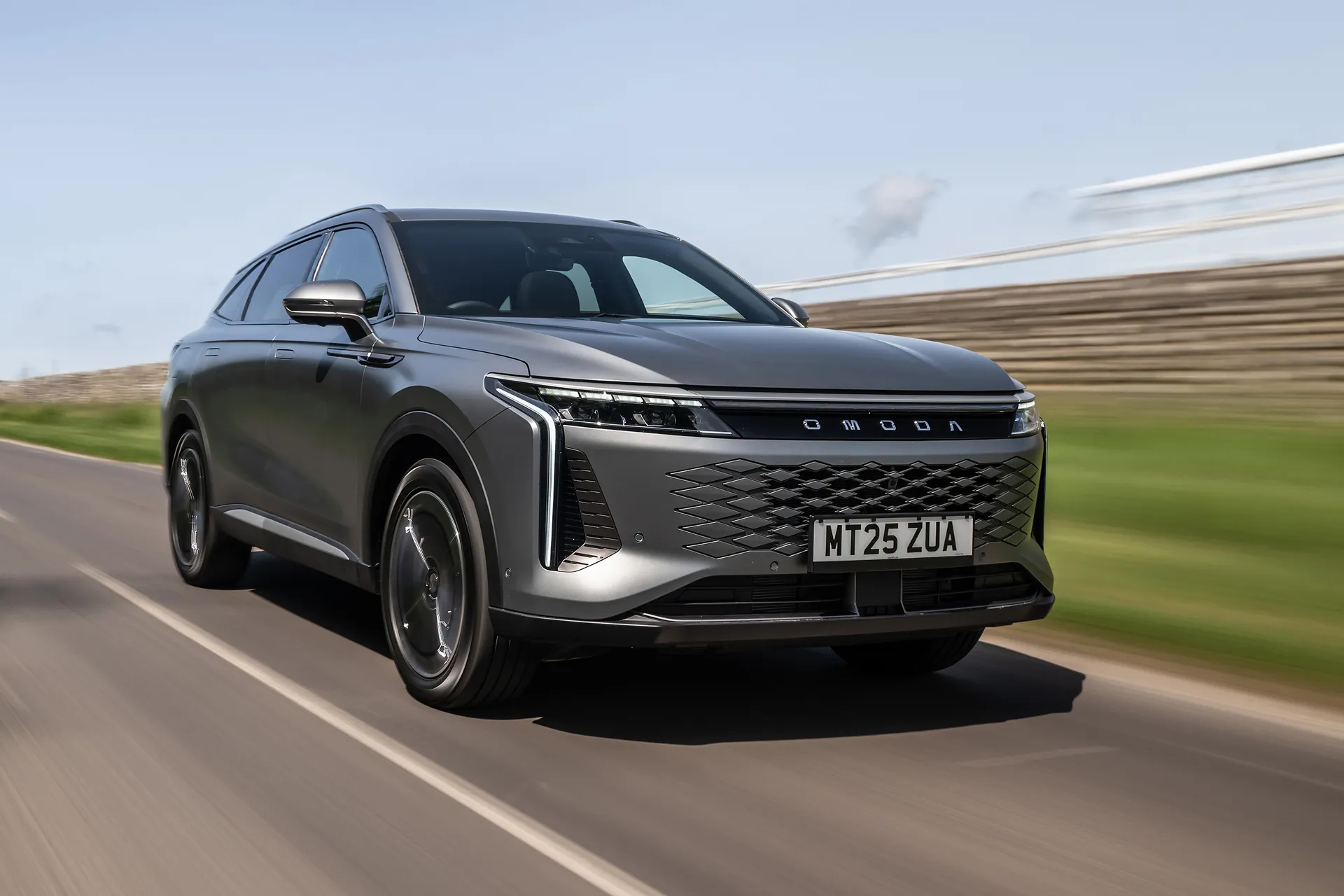
As standard, the car comes with adaptive suspension with continuous damper control, and by fiddling around with the settings in the appropriate touchscreen menu, you can alter its character between firmness and softness as you want.
And yes, you can feel some differences in behaviour when you play about with the settings, but if we’re honest, these differences are very marginal indeed. If you really, really concentrate, you might detect a fraction more patter to the ride in the firmer settings, and a fraction more float in the softer ones, but ultimately, these differences have very little effect on the level of comfort and enjoyment you feel.
It’s a good job, then, that in all these modes, the Omoda 9 does a thoroughly convincing job on the ride-and-handling front. Okay, so the ride isn’t quite as polished as those of the best luxury SUVs, and bigger, sharper-edged low-speed bumps can thunk into the cabin a bit, but most of the time, you waft along pretty comfortably, enjoying the impressive refinement that we’ll talk about more in a minute.
Similarly, while the handling isn’t the lesson in dynamism that the likes of BMW and Mercedes have been fearing, it is still perfectly capable. You can feel the vast size of the car as you change direction, but it turns ably, with strong grip and decent body control, and while the steering is a fraction slow to respond off the straight-ahead, it responds well enough afterwards and it’s quite nicely weighted.
What engines and gearboxes are available in the Omoda 9?
The Omoda 9 is offered exclusively with the firm’s SHS (Super Hybrid System) powertrain, which is a plug-in hybrid system.
It combines a 1.5-litre turbocharged petrol engine with two electric motors (one on each axle), a clever three-speed transmission, and a 34.5kWh lithium-iron phosphate battery. The various power sources are used in a variety of different ways according to what’s best for efficiency at the time. When the battery level is sufficient and the speeds are low enough, the car will run around using propulsion from either one or both of the electric motors, but when the battery is lower, or the car is cruising at motorway speeds or in need of maximum acceleration for an overtake, then the petrol engine will chime in, either to recharge the battery, or to help drive the wheels, or both.
When all the outputs for all the power sources are totted up, they come to a total of 449PS, which is quite a lot. Omoda gives the 0-62mph time, meanwhile at 4.9 seconds, which is fairly impressive for a car of this size. However, what does it feel like in reality?
Well, you will notice quite a long pause when you first put your foot down, while the movement of the throttle pedal registers with the powertrain, but once it does, you hurtle forwards briskly and smoothly. We can believe the quoted 0-62mph time, but the sensation of acceleration you get is more one of easy muscularity than one of trousers-on-fire lunacy.
And although that rather lazy throttle response never quite goes away (it’s supposed to be more aggressive and responsive when you switch the car to Sport mode, but you’ll struggle to detect any difference), the throttle is nevertheless easy to modulate, so it’s easy to regulate your rate of speed. And that’s an important thing, because it hasn’t been the case with some other Omoda/Jaecoo products we’ve tried.
Refinement and noise levels
The Omoda 9 is an impressively hushed car: indeed, it’s one of our favourite things about it. It’ll come as very little surprise that there’s almost no noise from the powertrain when the car is running in all-electric mode, keeping things impressively quiet and serene. What might be a little more surprising, though, is that there’s barely any more noise once the petrol engine kicks in. Most of the time, in fact, you’ll struggle to tell whether it's running at all. It does become audible on the odd occasion, but with the electric motors doing most of the heavy lifting, these occasions are very few and far between, and the noise is distanced and muted. The engine stays impressively smooth, too, with very little in the way of vibration making it through into the cabin.
The Omoda 9 has another trick up its sleeve, too: double-glazed side windows. These do a great job of isolating the noise of the wind rushing down the sides of the car, and although there’s a little more in the way of road noise, it’s at a low enough level that the 9 remains a very quiet and peaceful way of getting around.
If we’re really splitting hairs - and we mean really here - it’s that there’s so little other noise to be heard inside the cabin that you detect a slightly strange whistling noise that emanates from the windscreen area once you hit about 65mph. It’s very quiet - you won’t hear it if you have the radio on at even a low volume - and it’s not too troublesome, but it is slightly weird.
Safety equipment: How safe is the Omoda 9?
Omoda claims that safety is an absolute non-negotiable for its products, and that nothing but five-star safety ratings will do. The car has attained those ratings in other international markets in which it's been tested, but it hasn’t yet been tested by Euro NCAP, so we’ll have to wait and see how it fares when subjected to our testing standards. We’ll update this review as soon as it is.
That said, you can’t argue with the vast suite of ADAS (Advanced Driver Assistance Systems) measures that the car comes with as standard. These include front collision warning and autonomous emergency braking, rear cross traffic alert and braking, blind spot detection, driver monitor system, lane departure prevention, lane departure warning, emergency lane keeping, lane control assist, and traffic jam avoidance assist.
In case that little lot isn’t enough to prevent you from bending your car in the first place, there’s a collection of airbags and four Isofix child seat mounting points to help prevent you and your passengers from coming to harm.
If you’re one of those people to whom all those ADAS systems become intolerably annoying - and believe us, we can see why - then the Omoda has a neat feature. Swipe down from the top of the touchscreen, and you’re immediately presented with a menu that allows you to turn the offending systems off one by one. Thanks to European safety legislation, though, you’ll have to do this every time you start the car. However, most of the systems in the 9 aren’t as annoying or as intrusive as we’ve found them to be in other Omoda/Jaecoo models, so you might not have to as rigorously. With the exception, that is, of the driver attention monitor, which makes sure your eyes stay on the road for a sufficient portion of the time. That tells you off if you so much as think about glancing at the touchscreen, which you often have to, and so is very irritating.
MPG and fuel costs: How much does a Omoda 9 cost to run?
"The Omoda 9’s plug-in hybrid powertrain means it has the potential to be extremely cheap to run indeed, provided that you use it in the right way."
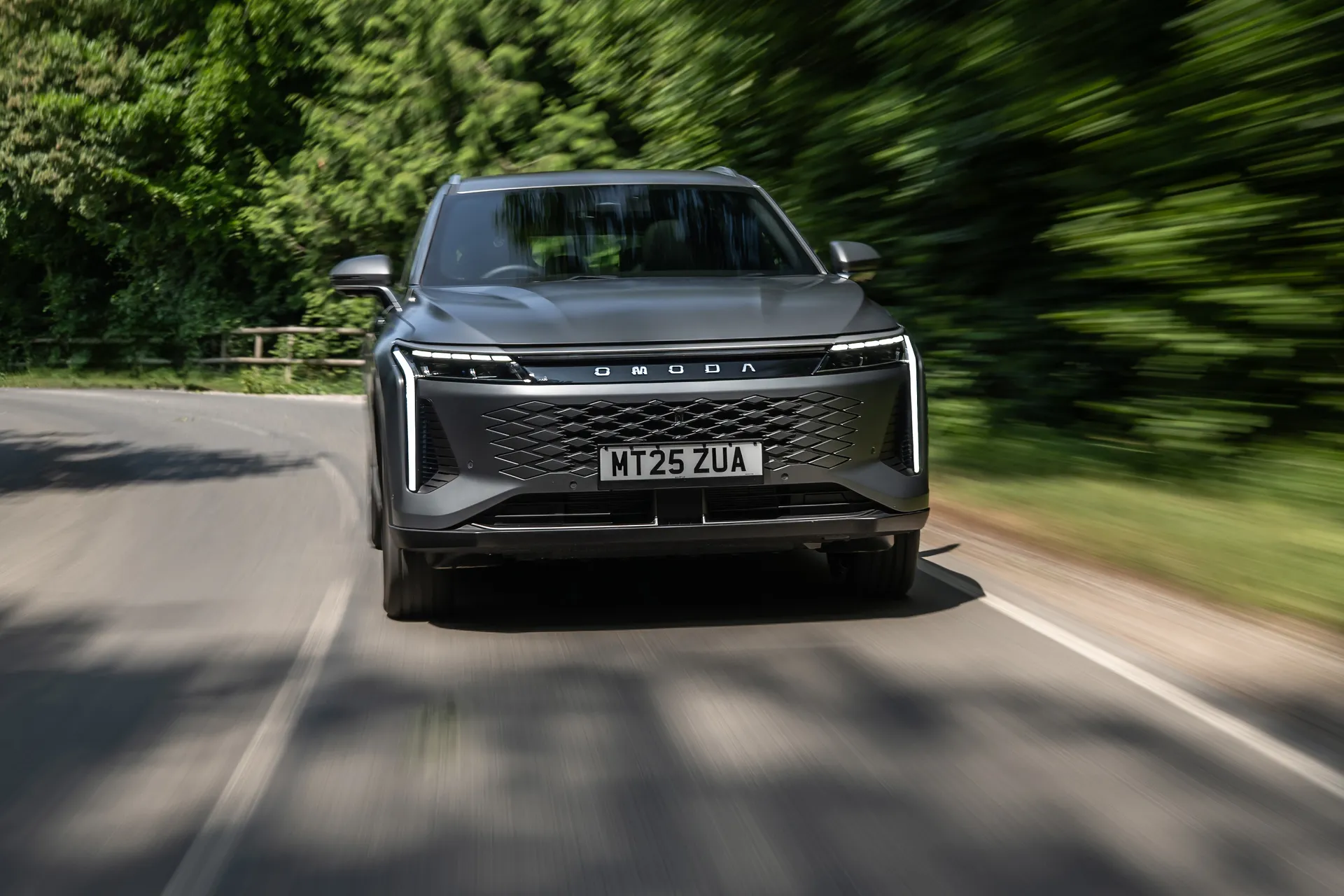
For best effect, you need to stay on top of charging the thing. This can be done at home in eight hours using the charging cable provided as standard, which plugs into any regular three-pin domestic socket.
If you happen to have a 7kW wallbox home EV charger, it’ll take about half that time, but you’ll need a different type of charging cable. If you’re charging while out and about, the Omoda 9 is rare among PHEVs in that it accepts DC rapid charging of up to 70kW, so topping up at a public charging station can take as little as 25 minutes.
Assuming your domestic electricity is billed at the UK’s national average rate. A full charge of your 34.5kWh battery will cost around £9, but you can cut that in half by charging your car overnight on discounted off-peak power. Beware, though, that using public chargers is much, much more expensive than home charging - we’re talking roughly three times more most of the time - so this should only ever be resorted to in emergencies if you want to keep costs down.
Like every plug-in hybrid, the Omoda 9 has an implausibly high fuel economy figure according to the official WLTP tests. That’s because the way these tests work is unrealistically flattering to PHEVs, so take the 201.8mpg quoted with a sizeable pinch of the white stuff.
The general rule to remember is that if you keep your car charged up and confine yourself solely to short journeys that can be undertaken on electric power alone - and with an impressively long all-electric range of 93 miles, you should have a good chance of doing that quite a lot of the time - then you won’t use a drop of fuel.
If you’re regularly calling upon the petrol engine, then your fuel cost will climb significantly, but perhaps not as much as with other plug-in hybrids. You see, with most of them, they become very thirsty indeed when the battery runs down because the petrol engine has to lug around the extra weight of the battery and motors. Omoda says the 9 is a little different, though, because when the car is left to its own devices, the battery is never allowed to fully deplete - it’s constantly being topped up by the petrol engine, or regeneration from the brakes and electric motors - and so there should always be enough energy for the car to be able to operate like a self-charging hybrid, making for better-than-normal economy when operating over longer distances. The figure quoted for this sort of use is a very reasonable 43.6mpg, which when you factor in the 93 miles of all electric range and the car’s 70-litre fuel tank, should give the car an overall range of more than 700 miles.
Omoda 9 reliability and warranty
The Omoda 9 is a brand new model from a brand new, er, brand, so historic reliability data simply doesn’t exist as yet, and the brand hasn’t yet featured in any of the various reliability and customer satisfaction surveys doing the rounds.
Having said that, while the Omoda brand is new to the UK, parent company Chery has been around for yonks, and happens to be very successful thank you very much, so you’d hope it knows how to build a reliable car by now.
It must be at least reasonably confident in those abilities, because Omoda offers the 9 with an impressive seven-year, 100,000-mile warranty, with no mileage limit for the first three years. The battery, meanwhile, is covered for eight years.
Omoda 9 insurance groups and costs
At the time of writing (June 2025), the Omoda 9 is so new that insurance groups haven’t yet been announced. We’ll update this review once this changes.
VED car tax: What is the annual road tax on a Omoda 9?
These days, all new cars are liable for the same flat rate of road tax regardless of the fuel they use, a flat rate currently charged at £195 per year. However, the Omoda 9’s price stands at more that £40,000 when new, meaning that it’s also liable for the government’s ‘luxury car supplement’. This means that, on top of the flat rate, you’ll also pay an additional sum of £425 per year for a five-year period between years two and six of the car’s life.
Omoda 9 price
"There’s only one version of the Omoda 9 offered, and when bought brand new, it costs around £45,000. It’s not exactly cheap, then, but considering the size of the car you get, the amount of standard equipment it comes with, and the fact that it has an advanced plug-in hybrid powertrain, it looks like sensational value for money."
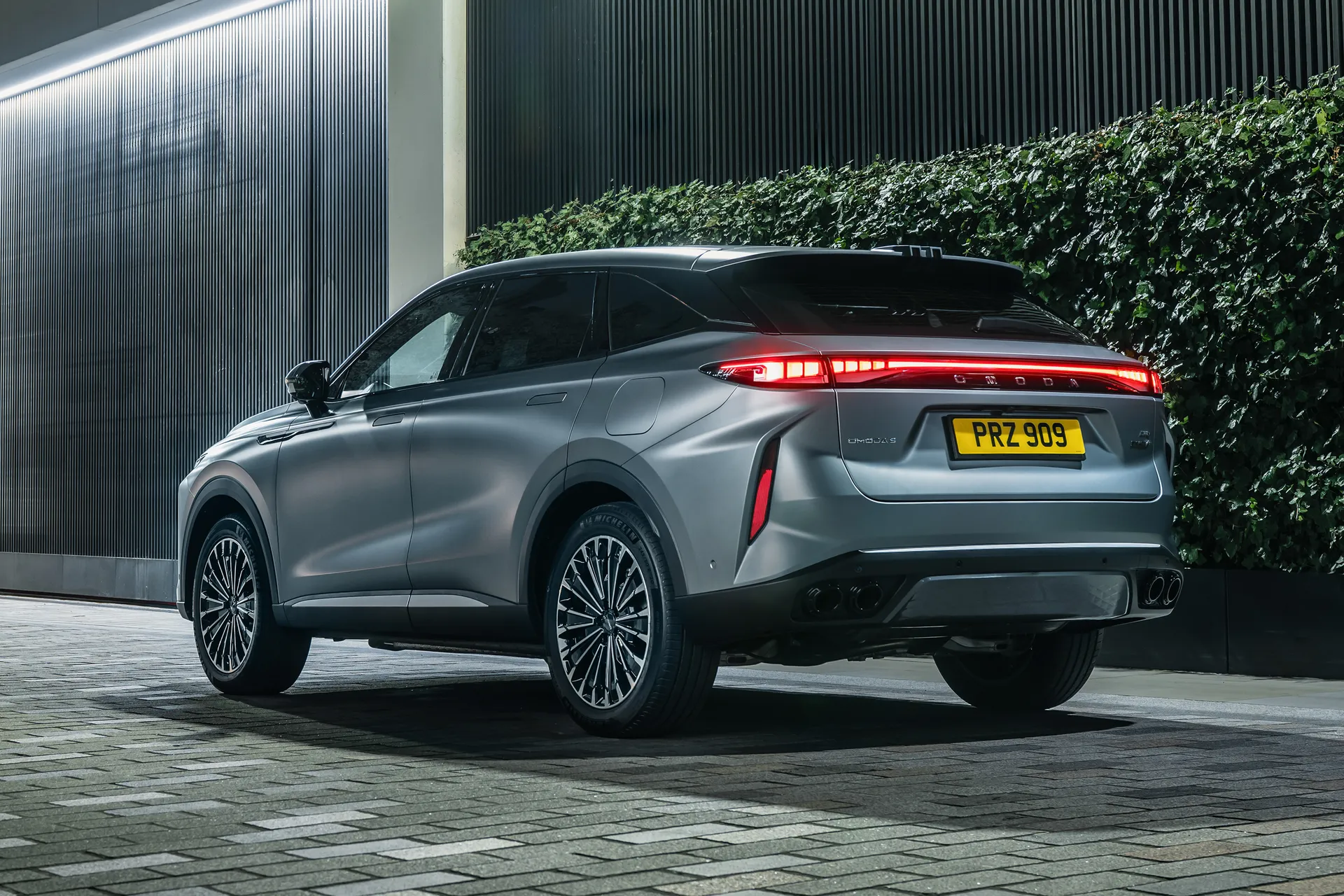
And that’s kind of the whole schtick with Omoda. The brand says that the car aims to provide D-segment (large) SUV luxury and kit for a C-segment (mid-size) SUV price. And the figures would seem to support that. The price is about the same as that of an entry-level Range Rover Evoque (a C-segment SUV), but specify your Evoque as a plug-in hybrid, and it’ll cost you around four grand more than the Omoda. Compare the Omoda to the more similarly sized Range Rover Velar (D-segment), and the Velar’s starting price is around ten grand more, while the cheapest PHEV version costs around twenty grand more. That’s fairly compelling.
The Omoda 9 is too new for there to be vast amounts of them sloshing around the used car market, but dealers will be keen to pre-register them, so it should be fairly easy to make further savings. And, when the only optional extra you can add is the colour of the paint, you gain very little by paying the extra to specify the car yourself, plus you’ll have to wait for it to be built and shipped.
Trim levels and standard equipment
Omoda adopts an ‘everything as standard’ approach to its cars, so with its Omoda 9 flagship, there’s just one single highly specified trim level offered, and it’s absolutely rammed with kit. The only optional extra you can add is exterior paint and, by the by, there are four colours to choose from if you don’t fancy the standard white.
On the outside of your car, you get large 20-inch alloy wheels, 134 LED daytime running lights on the front end, and a full-width LED light bar at the back. These lights do a 10-second welcome dance for you every time you unlock the car. You also get automatic headlights with automatic high beam, a 1.3-metre panoramic sunroof, and the adaptive suspension with continuous damper control.
On the inside, you get dual-zone climate control, multi-coloured ambient lighting, power-adjustment for the front seats, power reclining for the rear seats, heating and ventilation for the front-and outer-rear seats, vegan leather coverings for the seats and steering wheel, a heated steering wheel with four-way electric adjustment, a 540-degree panoramic view camera system (this gives you a view not only all around the car, but underneath it as well), and adaptive cruise control. And of course, all of that is on top of all the infotainment and safety gubbins we’ve already talked about.
Ask the heycar experts: common questions
What is the Omoda 9?
Is the Omoda 9 any good?
Is the Omoda 9 electric?
Get our latest advice, news and offers
Keep me updated by email with the latest advice, news and offers from heycar.
By submitting you agree to our privacy policy
